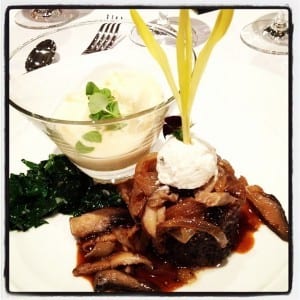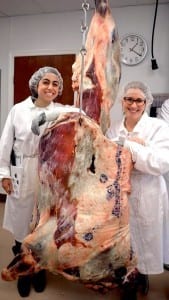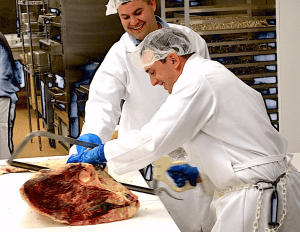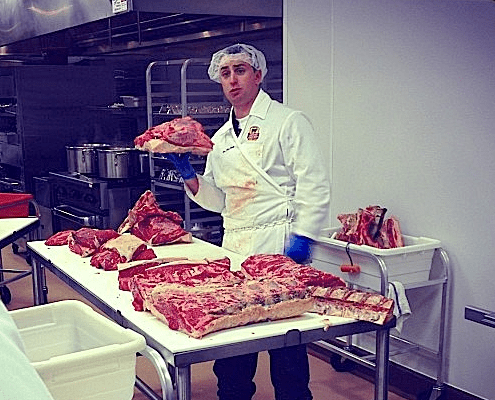Meet Dr. Phil, the eccentric Meat Scientist behind Certified Angus Beef.
By Carly De Filippo

In this emerging age of nose-to-tail butchery, pigs’ accessible size has them hogging much of the attention. Breaking down a side of beef intimidates most professional chefs, let alone amateur cooks. Enter Dr. Phil, the eccentric Meat Scientist behind Certified Angus Beef.
With a Ph.D in Meat Science, his own tagline – “Holy Cows!” – and a zany enthusiasm for all things meat, Phil Bass is the consummate instructor for Beef Butchery 101. This month, I was lucky enough to throw on a hairnet, grab a handsaw and pull out my “Texas butter knife” for his hands-on butchery course at CAB’s brand new Education & Culinary Center in rural Ohio. From measuring meat quality to cooking each cut, Dr. Phil explained beef production from farm to plate. I sat down with him after class to capture his essential insight and advice for home cooks.
What inspired your passion for meat science/beef butchery?
Ever since I could reach the meat-cutting table in my grandmother’s garage, to help butcher the cattle, sheep and hogs that my family harvested, I have had a passion and fascination for the meat cutting craft. Butchery is an art that is slowly being revived, and I am proud to have the basic knowledge and skill to identify and isolate both classic and contemporary beef cuts.

What are some of the newest trends in beef butchery that we should keep an eye out for?
Like the old saying goes, “hang on to something long enough and it will become cool again.” Old-fashioned, bone-in versions of cuts – from “cowboy” steaks to tenderloin and chuck short ribs – are very much en vogue. The Slow Food movement has sparked an interest in the nostalgic butcher’s market, including these bone-in cuts that younger generations have never really seen.
Are there any cheaper, lesser-known cuts that you feel are underutilized?
There are several cuts on the cusp of making it big. In reality, they have been around for several years, but it takes time for “new” beef cuts to make it to mainstream consumers.

Tri-tip is a tender, extremely flavorful roast cut from the bottom sirloin, which is perfect for grilling season. Growing up in California, Tri-tip was a regional favorite, but it is only now gaining traction in other areas.
Two other noteworthy contemporary cuts are the Ranch steak and the Denver steak. The lean Ranch steak comes from the “chuck” (outside shoulder) and is similar in tenderness to our top sirloin. It is currently part of the Arm Roast or English Roast that you’d find at your retailer, but with a little training, mainstream meat cutters could easily produce it as a grill-able item.
The Denver steak is cut from the inner shoulder and offers an extremely robust beef flavor. Traditionally, it would be ground or used for short ribs, but it also makes a great steak if aged appropriately for about 28 days. On a plate, it looks similar to New York strip steak, and has great potential as a price-conscious cut if it makes it to mainstream consumers.

I know your favorite cut of beef is the spinalis muscle. Can you describe why you prefer this cut and tell me if it is available in restaurants or butcher shops?
The spinalis, for lack of a better term, is the cap on the ribeye steak – the beautifully tender and extremely flavorful crescent on the outside of a ribeye that just screams “EAT ME!” This muscle obtains its tenderness in two ways: (1) due to its location on the cattle, it does very little work, and (2) it tends to have a large amount of marbling (flecks of fat in the lean meat), which imparts magnificent flavor. It is not readily available in the meat case, but nearly every meat counter in the country does have it.
To obtain the spinalis, ask your butcher to “seam out” the muscles of the prime rib, thus producing three cuts: the ribeye, the chuckeye (shaped like a small pork tenderloin) and the spinalis (which looks like a salmon filet in the raw). For the ideal eating experience, ask your butcher cut off all of the “silver skin” (connective tissue) on the spinalis and either grill it, roll it up and roast it, or use it in a roulade (I prefer a spinach-stuffed roulade).

What are 2-3 things a total novice should know about judging the quality of meat?
Marbling is hands-down the most important thing to look for when purchasing a cut of beef. It is the top contributor of flavor, tenderness and juiciness. Novice meat buyers should not balk at the sight of the little flecks of fat in the meat, but rather embrace it and become excited when it is present.
Next up is color: on freshly cut beef, the color of the lean meat should be a bright cherry red. Darker lean meat, although safe and wholesome, may pose some less than desirable eating attributes.
Finally, “Know Thy Cuts.” Different cuts require different cooking techniques – you don’t want to slow braise a grill cut or vice versa! A great resource on how to use different cuts is the “Beef Cuts” link on www.certifiedangusbeef.com, which provides pictures and cooking techniques for almost any cut you can find in a grocery store.
Are there any misconceptions about butchery you would like to address?
Butchery, fabrication, meat cutting, – whatever you call it – all results in a product produced by human hands. The craft itself is ancient. Ever since the first caveman cut up a wooly mammoth, the animals themselves have not changed all that much. Whether a consumer purchases their meat from a local neighborhood butcher or a national grocery chain, the harvesting and fabrication process is the same (albeit streamlined in some cases, depending on the source of the product).

Meat cutters at packing houses use the same knives, saws, and techniques as the small-town butcher, just on a much grander scale. In both cases, the quality of the meat itself will be biggest contributor to your eating experience -not who or how the meat was cut.
Moreover, food safety, cleanliness and wholesomeness are paramount for everyone in the meat (and food) communities. Outside of these parameters, it doesn’t really matter how high quality the meat is. Food safety is first and foremost; flavor is second.
How has the increased consumer interest in where food comes from affected your work?
Consumers have become “hyper-conscientious” about their food and this surge of interest has made us in the food industry extremely busy – in a good way! As their palates become more discerning, we are finding that people will pay more for a satisfying experience. Flavor, tenderness, juiciness and aroma are the traits that contribute to “taste,” which is the measure of this satisfaction and value. High quality meats – especially beef – are driving the animal agriculture industry to focus on quality rather than just quantity – which, in my opinion, is a really good thing.














